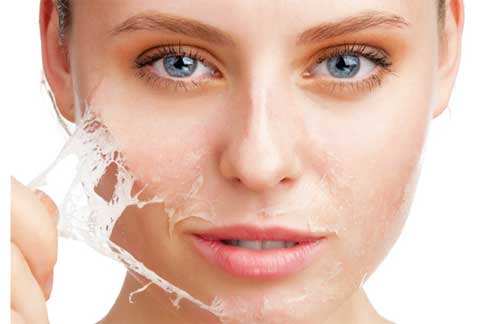+91 8275066599
Book an Appointment
info@myaesthetic.in
Book an Appointment
3/26,27, Gokhale Nagar Road
Pune - 411016, MH, India
Chemical Peels Treatment
Chemical peel treatments, also referred to as chemexfoliation, remove the outer layers of skin to improve overall skin function and enhance appearance. Their mechanism of action is based on the principles of wound healing whereby, controlled wounding of the skin with removal of skin layers helps to stimulate cell renewal, and regenerate.
-
Patient Selection
Patients with mild to moderate photoaging changes such as solar lentigines, dullness andrough skin texture , and acneic conditions, typically derive the most noticeable benefits with superficial chemical peels.
Fine lines, Enlarged Pores, and atrophic scars can also be improved with superficial peels; however, results are not comparable to those achieved with deeper skin resurfacing procedures, such as medium depth peels or laser resurfacing. Assessment of patients’ expectations at the time of consultation and commitment to a series of peels is essential to ensure success with superficial.
Superficial peels can be used in all skin types (Fitzpatrick I–VI) . However,patients with darker skin types (IV–VI) have greater risks of postinflammatory hyperpigmentationhemical peels healthier.

-
Indications
- Photodamage
- Rough texture
- Fine lines
- Hyperpigmentation
- Acne scars
- Keratosis pilaris
- Thickened scaling skin (e.g., icthyosis)
- Dry skin (xerosis)
- Seborrheic keratosis scaling
- Enhanced penetration of topical productswwPhotodamage
- Dull, sallow skin color
- Enlarged Pores
- Acne simplex (comedonal) and acne vulgaris (papulopustular)
-
Chemical Peel Classification
Chemical peels can be classified based on their depth of penetration into the skin as follows: very superficial, superficial, medium and deep
- Very superficial peels penetrate the stratum corneum and possibly the upper layers of the stratum spinosum in the epidermis
- Superficial peels penetrate the entire epidermis and possibly the papillary dermis
- Medium depth peels penetrate through the entire epidermis and possibly the upper reticular dermis
- Deep peels penetrate the midreticular dermis
-
Chemical Peel Products
Alpha Hydroxy Acids
Alpha hydroxy acids (AHAs) are some of the first agents that were used for chemical peeling. They are primarily derived from fruits and include
- glycolic (sugarcane)
- malic (apples)
- tartaric (grapes)
- citric (citrus)
- mandelic (almonds)
- lactic (milk), and
- phytic (rice) acids
AHAs penetrate into the stratum corneum and cause desquamation by breaking corneocyte desmosomal bonds. AHAs are also used in topical products as part of daily skin care regimens in low concentrations (10% or less) and in less acidic preparations (pH 3.5 or greater).
Glycolic acid (GA) is the most commonly used AHA. Glycolic acid peels are typically clear colorless solutions or gels that do not change in appearance upon application to the skin. As there is not a reliable visible clinical endpoint with GA peels, application must be timed and the acid neutralized at the appropriate point to control the procedure.
. Lactic acid (LA) is one of the more gentle acids and is inherently hydrating. After application to the skin, lactic acid forms lactate which is a component of the skin’s natural moisturizing factor that functions as a humectant. Lactic acid is used as a very superficial peeling agent in concentrations up to 50% and is frequently combined with other superficial peeling agents in blended peels.
-
Beta Hydroxy Acids
Salicylic acid (SA) is derived from willow tree bark, wintergreen oil and sweet birch. SA is a beta hydroxy acid and is found in concentrations up to 30% in superficial peels. Its lipophilic properties enable SA to penetrate and dissolve sebum, making it a highly effective therapy for acne.
In addition, it has anti-inflammatory effects which make it suitable for sensitive skin conditions, such as rosacea. b-lipohydroxy acid (LHA) is a newer peel, derived from SA, which has greater lipophilicity compared to SA.
Salicylic acid has a mild anesthetic effect and compared to AHAs, SA peels produce less stinging upon application. Many SA peel products have a visible clinical endpoint on the skin with a fine white powder (‘pseudofrost’) which is a salt precipitate of salicylic acid.
-
Trichloroacetic Acid
Trichloroacetic acid (TCA) is synthetically produced from acetic acid and chlorine. The resurfacing depth achieved with TCA ranges from superficial to deep depending on the acid concentration. It is commonly used as pure TCA in concentrations up to 20% for superficial peels.
When applied topically, TCA causes visible whitening of the skin, referred to as Frosting. The degree of frosting directly corresponds to the TCA depth of penetration in the skin. Level I frosting is the desired clinical endpoint for superficial peeling, and is visible as faint skin whitening with patchy erythema.
fix an appointment

